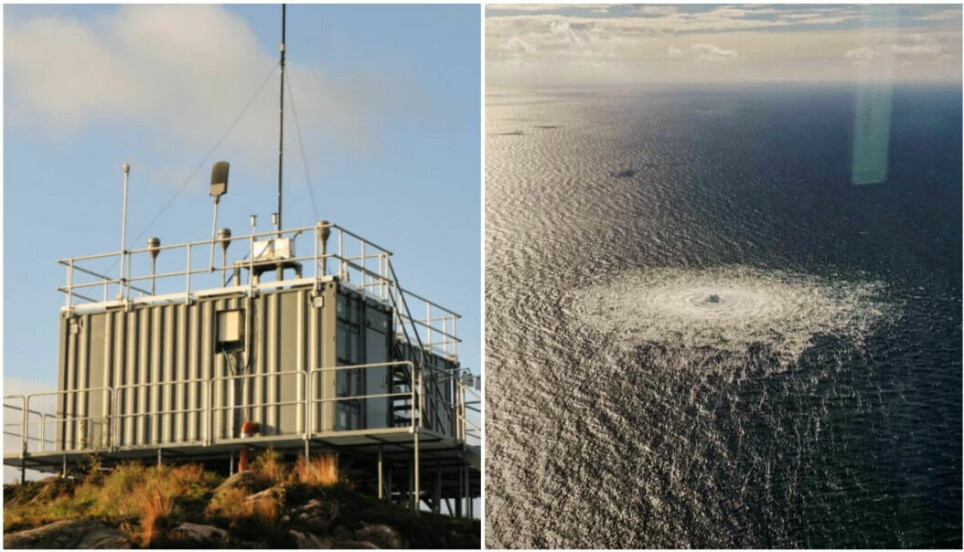
Gas leaks in the Baltic Sea: An observatory in southern Norway has recorded an extreme increase in the amount of methane in the air
“We have never seen anything like it,” says researcher from the Norwegian Institute for Air Research.
Following explosions in the Nord Stream 1 and Nord Stream 2 gas pipelines in the Baltic Sea, Norwegian scientists have measured large amounts of methane in the air.
“Some preliminary calculations we have done show that we are talking about many thousands of tonnes of methane that have been released,” climate scientist Stephen Matthew Platt at the Institute for Climate and Environment at the Norwegian Institute for Air Research (NILU) tells sciencenorway.no.
Increase of 400 ppb
Methane makes up an average of 1,800 ppb (parts per billion) of the air in the lower part of the Earth's atmosphere.
NILU's observatory at Birkenes in Agder in Southern Norway measured an increase of 400 ppb in the concentration of methane on Tuesday 27th of September.
“This is really a huge emission,” the climate scientist concludes. “And it happened in a relatively shallow sea area, so that a lot of the methane reaches the atmosphere.”
Double the emissions from Norwegian oil and gas
Methane is a significantly more powerful greenhouse gas than CO2 (carbon dioxide).
After CO2, methane is the man-made greenhouse gas that contributes the most to global warming.
The emission of methane from the gas pipelines in the Baltic Sea can correspond to as much as four times the total annual methane emissions from all Norwegian oil and gas production, according to calculations made by NILU.
“And this has happened within just a few days!” Platt exclaims.
The methane emission from the Baltic Sea is so high that it could lead to a measurable increase in the total methane emission from the entire Nordic region in 2022, Stephen Matthew Platt warns.
Not dangerous to humans
Platt emphasises that the increased amount of methane in the air over much of southern Scandinavia is not dangerous for humans or animals.
Methane is a colourless and odourless gas.
It is not very toxic.
“The gas cloud that is now spreading over the whole of the Nordic region will gradually thin out considerably,” Platt says. “We have not made any calculations that show in which direction it will move in the next few days. But we believe that it will soon be measurable at the second observatory NILU has in Svalbard.”
Act of sabotage
The two Nord Stream gas pipelines were not in use when they were exposed to what is most likely a sabotage operation in Swedish and Danish waters off the island of Bornholm in the Baltic Sea.
Nevertheless, the lines contained enormous amounts of natural gas, mainly methane gas.
According to the Danish Energy Agency, more than half of the gas had leaked out on Wednesday. But the leak could still last for several days.
Target to cut methane emissions by 30 per cent
Measured over a period of 20 years, methane has a potential for global warming that is 80 times higher than the same amount of CO2.
A reduction in methane emissions is considered to be absolutely crucial by climate scientists if we are to be able to achieve the goal of limiting global warming.
During the UN climate conference last year, more than a hundred countries signed a pledge, following the initiative of the US and the EU. Here the countries committed to cut methane emissions in the world by 30 per cent from 2020 to 2030.
NILU's observatories at Birkenes in Agder and on Svalbard are part of the European collaboration ICOS (Integrated Carbon Observation System). ICOS works to measure the amount of greenhouse gases in the atmosphere in Europe and neighbouring regions.
Edit: This article was updated on Friday 30th September at 14:30 with the fact that NILU believes the emissions could correspond to four times the total annual emissions from Norwegian oil and gas production. This is twice as much as what was in the first version of this article.
———
Translated by Alette Bjordal Gjellesvik.
Read the Norwegian version of this article on forskning.no
































